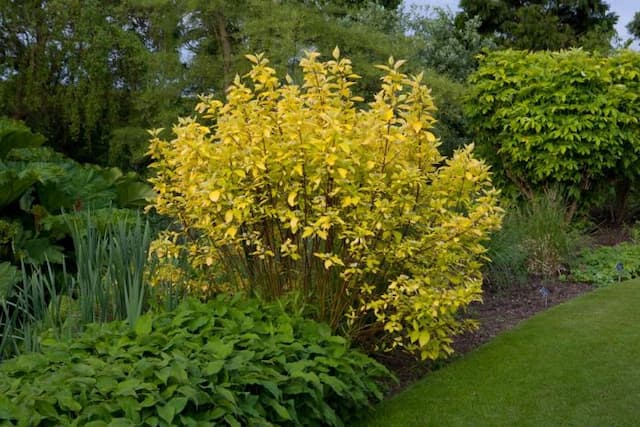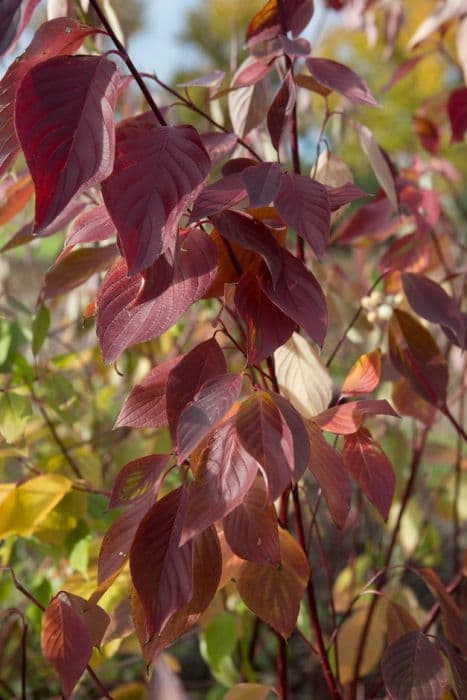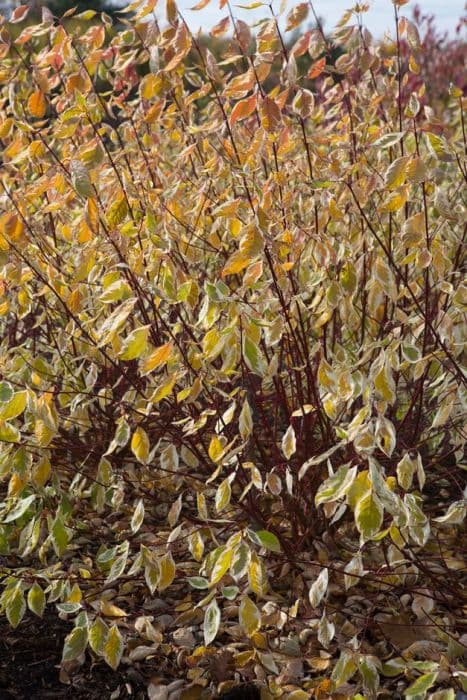Dogwood 'Winter Beauty' Cornus sanguinea 'Winter Beauty'











ABOUT
a deciduous shrub to 2m tall or more if left unpruned, with oval leaves turning orange-yellow in autumn; the winter stems are pale yellow below, red in the upper part
About this plant
 Names
NamesSynonyms
Bloodtwig Dogwood, Common Dogwood, European Dogwood, Winter Beauty Dogwood
Common names
Cornus sanguinea 'Winter Beauty'.
 Characteristics
CharacteristicsLife cycle
Perennials
Foliage type
Deciduous
Color of leaves
Green
Flower color
White
Height
6 feet (1.83 meters)
Spread
5 feet (1.52 meters)
Plant type
Shrub
Hardiness zones
5
Native area
Europe
Benefits
 General Benefits
General Benefits- Ornamental Value: Cornus sanguinea 'Winter Beauty', commonly known as Bloodtwig Dogwood, has striking winter stem color, providing visual interest in the landscape during the dormant season.
- Wildlife Attraction: The plant produces berries that are a food source for birds, helping sustain wildlife in your garden.
- Seasonal Interest: It offers a variety of seasonal changes ranging from flowers in spring, lush green foliage in summer, to vibrant leaf and stem colors in fall and winter.
- Erosion Control: Its root system can help stabilize soil and prevent erosion, especially on slopes or in areas with loose soil.
- Low Maintenance: Bloodtwig Dogwood is known for its hardiness and requires minimal care once established, making it a good choice for low-maintenance landscapes.
- Privacy Screen: When planted in a row or cluster, it can form a dense screen, providing privacy and reducing noise pollution.
 Medical Properties
Medical PropertiesThis plant is not used for medical purposes.
 Air-purifying Qualities
Air-purifying QualitiesThis plant is not specifically known for air purifying qualities.
 Other Uses
Other Uses- Cornus sanguinea 'Winter Beauty', commonly known as Bloodtwig Dogwood, can be used as a natural dye, where its bark and leaves can impart colors to fabrics and materials.
- Its straight stems can be harvested and utilized in basketry and weaving crafts for their flexibility and strength.
- The branches can be employed as garden stakes or plant supports in the growing season due to their durability.
- In floral arrangements, Bloodtwig Dogwood's brightly colored stems provide a striking contrast, particularly in winter-themed displays.
- The wood is sometimes carved into small ornamental items or used in woodturning projects for its fine-grained texture.
- Bloodtwig Dogwood can be planted as part of erosion control programs, especially on slopes and banks where its root system helps to stabilize the soil.
- The shrub can be used as a natural screen or hedge, offering privacy as well as habitat for birds and other wildlife.
- Its attractive winter stem color can inspire artists and photographers, making it a subject for artwork and botanical illustrations.
- Youthful shoots and branches can be crafted into rustic walking sticks or canes after proper treatment and drying.
- The plant's ability to thrive in damp areas makes it suitable for use in rain gardens, helping to manage stormwater runoff.
Interesting Facts
 Feng Shui
Feng ShuiThe Bloodtwig Dogwood is not used in Feng Shui practice.
 Zodiac Sign Compitability
Zodiac Sign CompitabilityThe Bloodtwig Dogwood is not used in astrology practice.
 Plant Symbolism
Plant Symbolism- Transformation: Cornus sanguinea 'Winter Beauty', commonly known as the Bloodtwig Dogwood or Winter Beauty dogwood, undergoes a striking transformation from summer to winter, symbolizing change and the ability to adapt.
- Vitality: With its vivid winter stem coloration, the Winter Beauty dogwood represents vitality amidst the dormancy of winter, reminding us of life's persistence.
- Protection: Historically, dogwoods were thought to ward off evil spirits, and so the Bloodtwig Dogwood is often associated with safety and protection.
- Resilience: Able to thrive in various conditions, the resilience of this plant symbolizes our capacity to endure and bounce back from adversity.
- Purity: The dogwood flower is traditionally a symbol of purity and innocence, qualities often attributed to this plant as well.
- Christian symbolism: In Christian symbolism, the dogwood is associated with the crucifixion of Jesus, symbolizing suffering, resurrection, and redemption, although this connection is more commonly tied to the flowering dogwood (Cornus florida).
 Water
WaterBloodtwig Dogwood should be watered thoroughly, allowing the soil to become moist but not waterlogged. A good rule of thumb is to water with approximately 1 to 2 gallons per week during the growing season, but this may vary depending on factors like soil type and weather conditions. During hot, dry periods, increase watering frequency to ensure the soil doesn't dry out completely. In the winter, reduce watering as the plant's water requirements decrease. Always check the soil moisture before watering to avoid overwatering, which can lead to root rot.
 Light
LightBloodtwig Dogwood thrives best in full sun to partial shade. The ideal spot would be where the plant receives morning sunlight and partial shade during the intense afternoon heat. However, it can tolerate a range of light conditions from full sun to mostly shade, although too much shade can reduce the vibrancy of its stem color and may lead to fewer flowers.
 Temperature
TemperatureBloodtwig Dogwood can withstand a range of temperatures but thrives best when the temperature is between 60°F and 75°F. The plant is hardy and can survive winter temperatures down to -30°F, while during the summer months, it can tolerate temperatures up to 95°F without any significant stress. Providing mulch around the base can help regulate soil temperature and provide protection during extreme temperature fluctuations.
 Pruning
PruningBloodtwig Dogwood benefits from pruning to maintain its shape and encourage vibrant stem color, which is most prominent on new growth. Prune in late winter or early spring before new leaves emerge, removing about a third of the oldest stems to ground level. This promotes the growth of new stems which will display the best color the following winter. Additionally, you can remove any damaged or crossing branches to maintain good air circulation.
 Cleaning
CleaningAs needed
 Soil
SoilBloodtwig Dogwood 'Winter Beauty' thrives in moist, well-drained soil rich in organic matter, with a pH of 5.5 to 7.5. A blend of garden soil, compost, and perlite or sand will create an ideal growing medium that supports root growth and retains adequate moisture without becoming waterlogged.
 Repotting
RepottingBloodtwig Dogwood 'Winter Beauty' is a garden shrub and generally does not require repotting. Instead, rejuvenation pruning every few years is recommended to maintain health and vigour.
 Humidity & Misting
Humidity & MistingBloodtwig Dogwood 'Winter Beauty' is tolerant of a range of humidity levels and does not have specific humidity requirements, making it suitable for most garden environments.
 Suitable locations
Suitable locationsIndoor
Not ideal indoors; needs full sun, periodic pruning, limited space.
Outdoor
Plant in full to partial sun, prune in early spring, mulch roots.
Hardiness zone
4-7 USDA
 Life cycle
Life cycleBloodtwig dogwood 'Winter Beauty' begins its life cycle as a seed that germinates in spring, sprouting into a seedling with basic root and shoot structures. As it matures during the growing season, the seedling develops a more complex root system and stems, eventually producing simple, ovate to lanceolate leaves. In its juvenile stage, the plant grows vigorously, but it does not flower or produce berries. Upon reaching maturity, usually after several years, 'Winter Beauty' produces small white flowers in late spring to early summer, grouped in cymes, which are attractive to pollinators. Following pollination, these flowers give way to clusters of black, berry-like drupes which are often eaten by birds. In autumn and winter, after leaf drop, the plant is particularly noted for its colorful red to coral stems, providing winter interest in the landscape, and after several years, the plant may undergo rejuvenation pruning to maintain its vibrant stem coloration and encourage new growth.
 Propogation
PropogationPropogation time
Midsummer
Cornus sanguinea 'Winter Beauty', commonly known as Bloodtwig Dogwood, is a plant that is often propagated by softwood cuttings during the late spring or early summer. To do this, gardeners select healthy, non-flowering shoots from the current season's growth and cut pieces around 5 to 6 inches (12.7 to 15.24 centimeters) in length. Each cutting should have several leaves and at least two nodes, which are the points on the stem where leaves are attached. The bottom leaves are removed, and the cutting base is often dipped in rooting hormone to increase the chances of successful root development. The prepared cuttings are then inserted into a moist potting mix and covered with a plastic bag or placed in a propagator to maintain high humidity levels. Within a few weeks, the cuttings should start to root, and once they have established a decent root system, they can be potted on individually and grown on until they are ready to be planted out.

![Dogwood [Baton Rouge]](/_next/image?url=https%3A%2F%2Fplants-admin.emdemapps.com%2Fimages%2Fplants%2F%2Fimages%2F604b59cf0fefd.png&w=640&q=75)


![Dogwood [Ivory Halo]](/_next/image?url=https%3A%2F%2Fplants-admin.emdemapps.com%2Fimages%2Fplants%2F%2Fimages%2F604b535cbcb9a.png&w=640&q=75)




